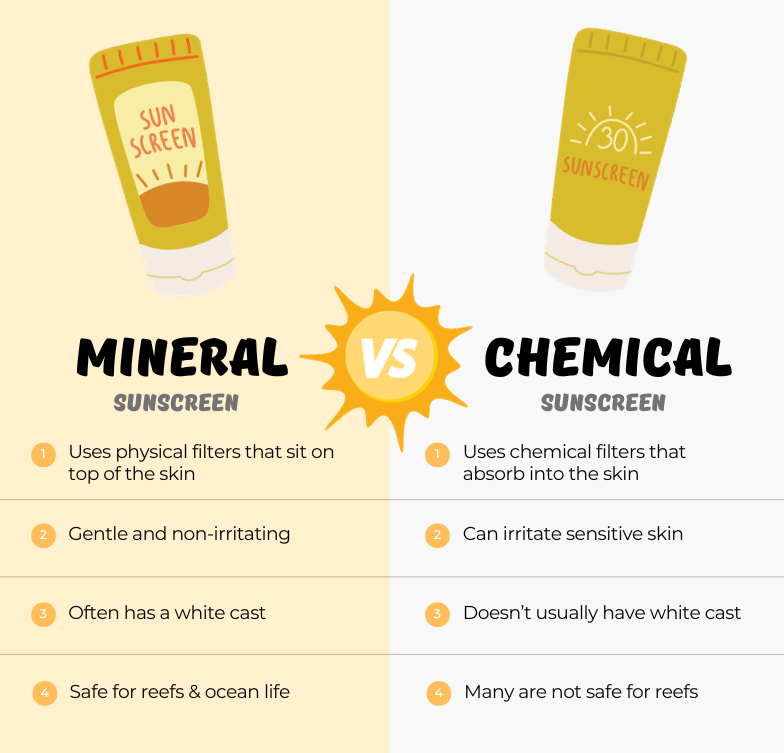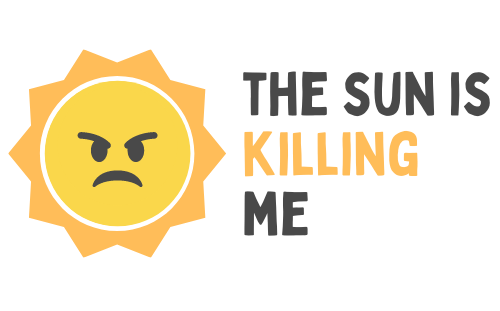When it comes to achieving that sublime, sun-kissed look, tanning takes center stage.
But there’s a twist (isn’t there always?).
We all crave that beautiful bronze, but it comes at a cost: sunburn, premature aging, or—brace yourselves—skin cancer.
So as a necessity, we reach for the sunscreen, our summertime superhero. But does sunscreen prevent tanning? Can you still achieve that brown glow without sunscreen?
It’s time we shed some light on this burning (pun intended) question.
How Does Sunscreen Prevent Tanning, Anyway?
The short answer to whether or not sunscreen stops you from tanning is a resounding — yes.. but not completely!
As we’ll explain later, you can still get some tanning in while wearing sunscreen. But if sunscreen did absolutely nothing to prevent us from tanning, it wouldn’t be very good at its job to protect our skin from the sun.
This is because tanning, in simplest terms, is our skin’s self-defense mechanism against the onslaught of those pesky ultraviolet (UV) rays.
While tanning could score high on the glamour quotient, and yes, it aids the production of Vitamin D, the risks are real and not to be taken lightly.
That’s where sunscreen comes in, whose main gig is to protect our precious skin.
When it comes to exactly how sunscreen prevents us from tanning, the answer is a bit more nuanced.
Different Types of Sunscreen: Chemical vs Physical Sunscreen
There are two main tribes in the sunscreen world: chemical and physical. They both have same mission of protecting us from UV rays, but their methods differ.
Chemical sunscreens tend to be more covert about this sun-stopping mission – they sink into your skin, absorb the UV rays, and convert them into harmless heat which is then released.
Neat, right?
They’re generally easier to apply and don’t leave that ghastly ghost-like cast.
Physical sunscreens are the sturdy wall that keeps the UV rays at bay. These sunscreens, containing natural ingredients like zinc oxide and titanium dioxide, form a physical shield on your skin, reflecting or scattering the UV rays.
While they might turn you a bit pale, they’re a safer option for sensitive skin, as the chemical filters like oxybenzone in chemical sunscreens tend to irritate sensitive skin types.

How Sunscreen Affects Tanning
So, does using sunscreen mean you’ll be pale as a beachside sandcastle?
Not quite!
Sunscreen doesn’t completely block out the sun’s rays but filters them, protecting your skin from harm while still allowing a small amount to induce some tanning.
Even a sunscreen with a higher SPF (aka sun protection factor) doesn’t mean no tan, it just implies less of the sun’s UV rays hitting your skin. The SPF rating each sunscreen has indicates the amount of UVB rays it blocks.
So, for example:
- SPF 15 blocks 93%
- SPF 30 blocks 97%
- SPF 100 blocks 99%
You can see that even SPF 100 does not block out 100% of UV rays, so you always have the possibility of getting some color, even at that highest SPF tier.

What About UVA?
SPF is the rating system designed to measure the amount of UVB protection each sunscreen offers. UVB rays are those more responsible for sun burns and skin cancer.
That being said, UVA rays are no treat either. They’re primarily responsible for increased aging and wrinkles — although they can cause skin cancer too. Any sunscreen that is labeled as “broad spectrum sunscreen” protects against both UVA and UVB rays.
Think Less About SPF, More About Skin Type
In reality, the frequency with which you reapply your sunscreen, how long you stay under the sun, and you skin type all has more of a role to play in achieving (or missing) that tan than simple SPF.
Some skin types (like the ones and twos on the Fitzpatrick skin type scale) will never tan, no matter how low the SPF they choose or how long they stay out — they’ll only burn!
Make sure you understand your skin type before attempting to achieve any kind of bronze-ing effect.
What Happens to Your Skin When You Tan
The sad truth is that there is really such thing as a “safe” tan.
A tan technically is your skin’s SOS.
Exposure to UV radiation from the sun prompts our skin to produce more melanin, a pigment that darkens our skin to protect from further sun damage. So, while a tan might make you look like a sun goddess, beneath the bronze, your skin cells are battling solar assault, trying to protect your cells from genetic damage.
Whether you tan to a golden hue to turn red as a lobster, it’s all due to your skin is getting damaged.
Over time, this translates to leathery, prematurely aged skin and, in worst cases, skin cancer.
How to Tan With Sunscreen a Bit Safer
As we said before, there is no such thing as a “safe” tan. That being said, if you decide achieving that golden look is worth the risk, there are at least some steps you can take to stay a bit more safe:
- Use at least a broad-spectrum SPF 30 or higher. It may seem like a lower SPF is the way to go, but you’re better off keeping your skin safer and tanning nice and slow rather than under-protecting yourself from damaging UV rays.
- Apply sunscreen 15-20 minutes before sunbathing. This gives your sunscreen ample time to absorb or settle onto your skin.
- Limit sunbathing sessions to 10-15 minutes at a time, taking breaks in between. This practice is referred to as gradual tanning is where you spend time sun bathing in small time slots, preventing overexposure. During breaks, seek out shade or cover up with a UPF shawl or hoodie.
- Reapply sunscreen every two hours. And if you’re taking a dip or working up a sweat, it needs to be reapplied immediately post that activities.
- Avoid prime sun time. The sun’s rays are at their harshest between 10 a.m. and 2 p.m. When the sun stands high, you should lie low — especially if you’re on the lower end of the SPF scale.
Thinking of Using a Tanning Bed? Think Again
New age tanning myths like “tanning beds are safer than natural sun” looks great on a spa brochure, but in reality, tanning beds aren’t just equally as bad as outdoor tanning — they’re actually much, much worse.
According to the American Academy of Dermatology, using tanning beds before age 35 can increase your likelihood of developing melanoma by 59%. No thank you!
Risks and Benefits of Tanning with Sunscreen: Is It Worth It?
Sure, tanning might kick your selfies up a notch, but the scale of risk far outweighs the benefits. Regular sun exposure sans protection wreaks havoc on your skin, leading to premature aging, sun spots, and potentially skin cancer.
Despite the prevailing tanning culture, the consensus amongst dermatologists is clear: no tan is a safe tan, even with sunscreen.
Sun-damaged skin isn’t a badge of honor – your skin health is far more important than a summer glow.
Always opt for a safe, sunless tanning option if you’re after that bronzed look.
Safer Tanning Alternatives: Glow Without Woe
Achieving that copper-kissed radiance shouldn’t have to mean waging war against your skin. Here’s the S.O.S (Save Our Skin) of safe tanning:
- Sunless Self-Tanners: These guys provide a natural-looking tan without any sun damage—just apply, let it touch-dry, and voila! You’ve got a sun-kissed glow without staring down the sun.
- Bronzers: A bit of well-placed bronzer can give you that “just back from a beach vacation” look. Pssst! Don’t forget to blend.
- Spray Tan: A professional spray tan can give you a full-body tan in minutes. Plus, it’ll make you feel like you’re walking the red carpet.
- Gradual Tan Moisturizers: Hydrate and tan simultaneously – now that’s multitasking! Over time, these moisturizers build up a natural-looking tan. Win-win!
- Tan Towels: Swipe these pre-soaked towelettes over your skin to build a gradual, even tan. Ideal for tan touch-ups on the go!
- Tinted Sunscreens: These double-duty champions offer sun protection while matching your skin tone. Essentially, a tinted sunscreen is like face makeup and sunscreen rolled into one.
Our advice?
Don’t think of SPF as a “tan-prevention” measure, but instead as a “sun damage-prevention” superhero.
A SPF30 sunscreen will protect you from more UV radiation than an SPF15, but none will block 100% of the UV rays, so some degree of tanning can occur.
Sun worshippers across the globe, your quest for that tawny hue may be understandable, but it’s not a mission worth pursuing in the end. But with our array of safe fake tanning options, you can flaunt that golden glow without compromising your skin’s health.
Have any other favorite safe fake tanning methods you want to share? Leave ’em in the comments!
FAQs on Whether Sunscreen Prevents Tanning
Does sunscreen prevent me from tanning?
Sunscreen does not prevent tanning completely. It acts as a filter, reducing the amount of UV radiation reaching the skin and hence, reducing the tan. The level of protection depends on the effectiveness of the sunscreen (indicated by SPF levels) and how correctly and liberally it’s applied. But even SPF 100 only blocks 99% of UV rays — there’s always the possibility for a bit of tanning due to sun exposure.
Can you tan with sunscreen on?
Yes, you can still get a tan with sunscreen on. Sunscreen’s main function is to block out harmful UV radiation, but some still gets through which can cause your skin to tan. However, a higher SPF sunscreen will limit the amount of UV rays that reach your skin, decreasing the degree of your tan.
Can you still tan with SPF 50?
Yes, you can still tan with SPF 50. No sunscreen can block 100% of the sun’s rays. While an SPF 50 sunscreen allows only 2% of the sun’s rays to hit your skin, those rays can still cause tanning – though it will be significantly less than without protection.

